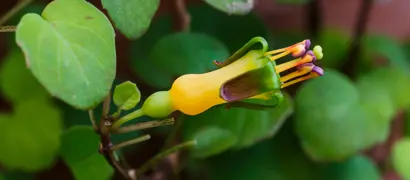Fuchsia Procumbens Characteristics
Fuchsia procumbens, commonly known as creeping fuchsia, is a unique and charming evergreen groundcover native to New Zealand. Some of its characteristics include:

Fuchsia procumbens, a charming and unusual fuchsia native to New Zealand, is a low-growing, spreading shrub. Unlike its taller relatives, it hugs the ground, making it an excellent groundcover. Fuchsia procumbens is a unique and delightful New Zealand native.
There is a wealth of information about Fuchsia procumbens in NZ, and The Plant Company is often asked specific questions about them. Those questions and answers are laid out in this section.

Fuchsia procumbens, commonly known as creeping fuchsia, is a unique and charming evergreen groundcover native to New Zealand. Some of its characteristics include:
Growth Habit
Foliage
Flowers
Fruit
Natural habitat
Preferred growing conditions

Fuchsia procumbens, commonly known as creeping fuchsia, is native to New Zealand. In fact, it's considered endemic to New Zealand, meaning it doesn't grow naturally anywhere else in the world. They are quite common throughout North Island coastal areas from Ninety Mile Beach to Coromandel.

Fuchsia procumbens can be considered New Zealand's fuchsia because:
All of these characteristics makes it a special fuchsia that is uniquely New Zealand!

Fusia is the incorrect spelling of Fuchsia, so yes, they are the same plant.

Fuchsia procumbens is found naturally in coastal areas north of Auckland and across to Coromandel Peninsula, as well as Kapiti Island. In these areas it has been found on gravel beaches, coastal cliff faces, scrub and grassland areas adjacent to the coast, and on the edges of saltmarshes. Suffice to say, Fuchsia procumbens is a tough plant that can tolerate coastal climates, a degree of wind exposure, and dry periods.
Planting Creeping Fuchsia and getting them to grow well is generally easy when you get a few of the basics right. This involves planting them in the right soil type, choosing the most ideal planting position, and ensuring the plants have the essentials to thrive. The Plant Company has the right advice to ensure success!

Fuchsia procumbens is known for being a low-growing groundcover. It typically grows to 10-15 cm tall and will spread about 60 cm wide. There will be variations on these sizes depending on factors such as sunlight, watering, fertility, soil conditions, and plant competition.

Fuchsia procumbens is relatively low maintenance, but there are a few things you can do to help get the most from you creeping fuchsia:

Choose a partial shade position with good drainage for your Fuchsia procumbens. The hole should be dug to at least 50-75% deeper and wider than the container the plant is currently growing in. A planting spade makes the hole digging a lot easier. The Plant Company recommends incorporating compost or sheep pellets into the soil to provide additional organic material, but this is not essential. Do not put fertiliser in the bottom of the hole, rather spread that on the soil surface after planting, and preferably do this when the plant is actively growing in spring.
Remove the plant from the container it is growing in by either pulling it free or by cutting the bag. We recommend cutting the bag or container, especially for larger grade plants, to minimise any chance of damaging the roots. If the roots have been growing in a circle or are all bound up, you can tease them apart if you want but this is not essential. Similarly, you don’t need to remove any of the growing media. The Plant Company does not recommend cutting the roots, even if the plant is root-bound as this offers no benefit. This is explained in our article, Managing Rootbound Plants.
Now place the plant in the hole and make sure it is level with the soil surface before filling in around it. If it is above the soil surface, dig more out. If it is below, put in more soil and retest the level. Once the plant is set level with the soil surface, add more soil gradually and firm it around the plant using gentle pressure as you go. Scatter native plant fertiliser across the soil surface after planting and the give the plant a good watering.

Fuchsia procumbens, with its charming low-growing habit and attractive foliage, offers several benefits for gardeners. Here are some of the common garden uses for this unique, New Zealand native:
Adding to its wide versatility, Fuchsia procumbens is a relatively low-maintenance plant. It's fast-growing, adaptable to various light conditions, and requires minimal pruning.

Fuchsia procumbens, also known as creeping fuchsia or trailing fuchsia, is a versatile plant that can thrive in a variety of locations. It will tolerate coastal environments and wind, but it does, however, have some preferred growing conditions:
Whether you need assistance finding the plant you’re looking for or you simply want to know more about who we are and what we do, we invite you to get in touch with us today. A member of The Plant Company team will get back in touch as soon as possible.
